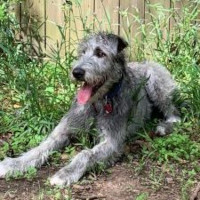Appearance of the Giant Irish Wolf Schnauzer
|
| The Giant Irish Wolf Schnauzer is a very large animal with a square or slightly rectangular silhouette. Dogs that prefer their Irish Greyhound heritage will have a long, narrow head with a long, pointed muzzle covered in fine, short hair, while those that prefer the Giant Schnauzer will have a heavy, brick-like head with a broad but slightly tapered muzzle. which often sports copious facial furnishings that often form a mustache and beard. The eyes of this hybrid are usually dark brown and may be oval or almond-shaped, and the ears will be set high on the skull and folded forward. Some Schnauzer owners choose to have their ears cropped so that they stand upright, and some Irish Wolf Schnauzer owners choose to do the same. It's important to note that ear docking is no longer permitted for non-medical reasons in many countries. |
Temperament of the Giant Irish Wolf Schnauzer
|
| The Giant Irish Wolf Schnauzer is a powerful, athletic animal, with a strong prey drive and imposing face. They can be energetic, especially in their teens, but they are also capable of settling down and being calm in their homes. The Irish Greyhound is known as a gentle giant, however, Schnauzers are known to be a little more exuberant and can be unintentionally destructive. Although it's unlikely that a well-socialized Giant Irish Wolf Schnauzer will be intentionally aggressive towards a child, all interactions should be closely monitored to avoid misunderstandings and exuberant or rough treatment on the part of either the animal or the child. Their prey drive can make them poor housemates for other animals, especially smaller, faster ones, and Giant Schnauzers are known to show fear or aggression towards other dogs. Although these dogs are quite intelligent, they can be a challenge to train as they can also be quite stubborn and strong-willed, and starting training as early as possible can help mitigate defiant behavior. |
Needs and activities of the Giant Irish Wolf Schnauzer
|
| Although the Irish Greyhound can tend to become a bit of a couch potato as it ages, the Giant Schnauzer is an active and athletic dog, so the Giant Irish Wolf Schnauzer needs at least 60 to 90 minutes of vigorous exercise throughout the day every day to keep it as happy and healthy as possible. Due to its size, this crossbreed may be susceptible to developing skeletal disorders if it is allowed to play too rough or overtax its joints by walking or jogging too far at a time while their bones are still developing during their teenage years. In addition to walking and jogging, this dog can also excel at and enjoy activities such as obedience training, swimming, agility training and rallies. |
Maintenance of the Giant Irish Wolf Schnauzer
|
| The shedding rate of this crossbreed is low enough for the Giant Irish Wolf Schnauzer to be considered hypoallergenic, but choosing to share your home with a Giant Irish Wolf Schnauzer means you're committing yourself to a fairly high grooming requirement compared to many other dogs, even if it's not usually a daily chore. Brushing the Giant Irish Wolf Schnauzer is only required once or twice a week, however, brushing sessions for this hybrid tend to be longer than brushing sessions for many other dogs due to both their unique coats and the dog's size. Combing through the coat will help loosen dirt as well as remove tangles or foreign objects like twigs or grass seeds, and a follow-up with a smoother brush or stiff bristle brush will help untangle the last of the tangles as well as remove dead hair, further reducing the dog's shedding rate. Bathing should only take place every few months, and is best done after the dog has been combed and brushed. Stripping the coat will be necessary every four to six months, either using a special stripping comb, or by hand stripping the coat, and depending on how the coat grows, it may need to be shaped and sheared regularly. If your dog develops a beard, it's essential to clean it after every meal, as water, food and saliva can quickly become smelly and unsanitary. |









 English (United Kingdom)
English (United Kingdom)